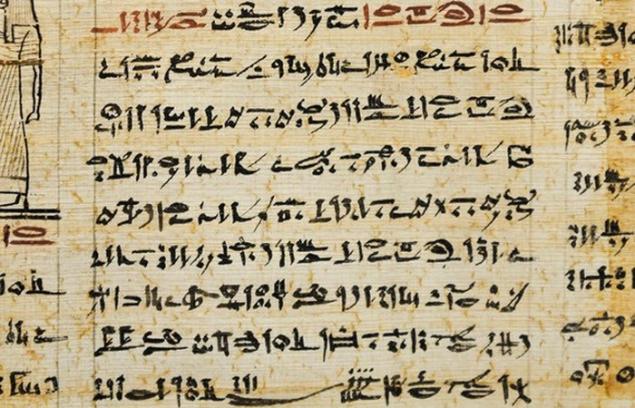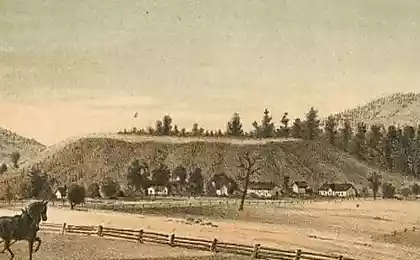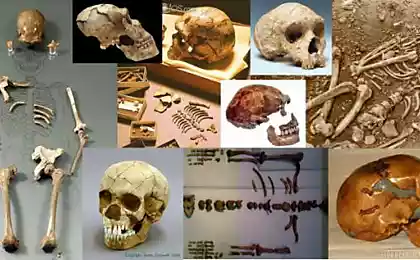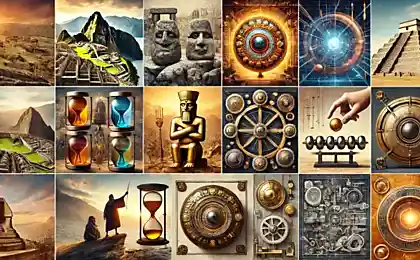752
10 archaeological findings that shed light on life in ancient Egypt
Ancient Egypt - amazing culture. Monuments of the time, such as the Great Pyramids and the Sphinx, causing awe and today people. The interest of researchers produce and ancient Egyptian papyri. After all, Egypt - one of the earliest cultures, representatives of which were detailed notes of everything happening. But today scientists know far not all the secrets of ancient Egypt, and researchers continue to make great discoveries. < Website says that at the moment we know the science of life in ancient Egypt
meteoric iron
Photo source:. Novate.ruV Egyptian city Girzy in 1911, archaeologists We found the tomb, which was stored in nine metallic beads. Incredibly, it was found that the beads appeared 2,000 years earlier than in Egypt began to smelt iron. Since then, historians have puzzled over where the ancient Egyptians took the iron to the beads. Egyptian hieroglyph, which is designated iron, literally translated as "metal sky", which gives a very good reference to understand its origin.
Due to the rarity of the metal, it is mainly associated with wealth and power. Because it is mainly produced jewelry and trinkets for the royal family, and not a weapon, as it was adopted later. In the 1980s, the chemical analysis showed that the level of nickel in the beads was similar to the one found in meteorites. So the Egyptians thousands of years before they learned to smelt the metal, iron appeared. It may also explain the mystery of Tutankhamun dagger, made of iron and gold.
Religious Tattoos
Today people get tattoos for different reasons: to impress a loved one, to emphasize their difference from others or share their interests. The mummy, found in the village of Deir el-Medina, was the confirmation that the tattoos were from the ancient Egyptians. Mummy Deir el-Medina - headless and armless torso, which was owned by a woman who lived between 1300 and 1070 years BC. e.
Using infrared light thereon distinct tattoos 30 was detected. What is unique in this mummy, tattoo it did during his lifetime, not after death as a religious ritual. Most characters have been devoted to the mighty goddess Hathor. Soon three similar mummies, tattoos were also used for the expression of religious piety were found.
Images demons
Even 4000 years ago, the Egyptians were very much afraid of demons. However, until recently scientists had no idea how the Egyptians represented them. It was not until as long as you did not find two coffins dating from the Middle Kingdom (about 4,500 years ago), in which the image of the world's oldest demons were found. One of them, called In-MEP, was a mixture of dog and baboon, and another on behalf of Cherry-Benut, was a strange creature with a human head.
The demons are depicted as two guards the entrance to the tomb, but what they actually met is unknown. Also at another tomb was found Ikenti image - a demon that looked like a big bird with a cat's head
ancient heart disease
. Atherosclerosis - a chronic disease of the arteries, which is now very widespread. A sedentary lifestyle and a diet rich in fatty foods contribute to this disease. It is not surprising that doctors thought: atherosclerosis - a fairly new disease and it was not common in ancient populations. Egyptologists have also found that it was a very common disease and thousands of years ago.
After examining 52 mummies at the National Museum of Antiquities in Cairo it revealed that 20 of them had signs of calcification, which means that they are likely to suffer from atherosclerosis in their lifetime. Their age averaged about 45 years, and they lived in the 16th century BC. One of the mummies belonged to the royal family, namely princess Ahmose-Meriet-Amon, who lived in Thebes, and died in forty years. It is considered the oldest person who had coronary artery disease.
Egyptian ladies
In modern days, when a woman's hair begin to thin out, there are several ways to fix it. It seems that women in the past had the same problem, because the remains of the woman who was found in a ruined Egyptian city of Amarna, was 70 of extension hair, similar to those used today.
Her hair was so well made that they have survived to this day, though the rest of the woman's body disintegrated (she died 3300 years ago and was not mummified). At the cemetery, where he was buried a woman, were found and other body hair, dyed with henna.
Mummified embryo
About 100 years ago it was excavated in Giza 45-inch sargofag. He was taken to the University of Cambridge, where he was sent to the store and forget about it. Originally thought that the tiny coffin separate bodies placed for an unknown reason. But after careful study by MRI discovered that it is actually 16-18 week human embryo, which is mummified and buried in its own purpose-built sarcophagus for him, which contained the intricate designs and decorations.
Cancer in Egyptians
Like heart disease, cancer, until recently, it was considered a purely modern disease. About this disease was never mentioned in the historical records. However, this does not mean that the cancer has not been in the ancient world. According to recent studies, the two mummies, male and female, are signs that they are suffering from cancer have been found.
In 2015, the Spanish University found a mummy that has signs of damage from breast cancer have been found. 4200-year-old mummy - a woman who lived during the sixth dynasty of pharaohs
ancient papyrus 59,979,034
. In 2011, archaeologist Pierre Tallet made a remarkable discovery in a remote area of Egypt, far from any civilization. In thirty caves in the limestone rock showed a kind of warehouse for the storage of boats in ancient Egypt. But even more stunning was the discovery that he had made a few years later, in 2013 - a series of papyrus, written on both sides with hieroglyphics and hieratic (informal, everyday writing of the ancient Egyptians), the papyri are the oldest papyri that have ever been found.
official journal was found among them named Merer, who led a group of 200 men, responsible for the provision of materials and provisions of workers in the construction of the Great Pyramid.
brain drain in ancient Egyptian 63,850,034
In 525 BC. e., the Persian king Cambyses conquered the Egyptian capital Memphis. After the conquest of Egypt, the great majority of Egyptian minds and artists began to export to Persia, there to serve the Empire. In Egypt, there were only mediocre artists, which is perfectly visible on the tomb, discovered in 2014. Despite the fact that the body in the coffin was found, scientists have found that the tomb dates from about the years of Persian occupation.
Interestingly, initially thought that the tomb is a fake because it was made very crudely and poorly. However, later it turned out that it is really original. On the tomb there is a lot of bizarre images, including poorly drawn Falcons (symbols of the god Horus), which are more like fish, four banks with the heads of the four sons of Horus, who were described as "headless" and other blunders on Egyptian mythology.
Egyptian sexual spells
In 2016, two scrolls of papyrus of the third century AD were transcribed, which were written in Greek. 1700-year-old scrolls that were found a century ago, were kept in the University of Oxford in England. Only now it turned out that they were written by the sexual spells designed to fall in love with another man. Author unknown spells, but they are mentioned several Gnostic gods.
via www.novate.ru/blogs/230616/36895/
meteoric iron

Photo source:. Novate.ruV Egyptian city Girzy in 1911, archaeologists We found the tomb, which was stored in nine metallic beads. Incredibly, it was found that the beads appeared 2,000 years earlier than in Egypt began to smelt iron. Since then, historians have puzzled over where the ancient Egyptians took the iron to the beads. Egyptian hieroglyph, which is designated iron, literally translated as "metal sky", which gives a very good reference to understand its origin.
Due to the rarity of the metal, it is mainly associated with wealth and power. Because it is mainly produced jewelry and trinkets for the royal family, and not a weapon, as it was adopted later. In the 1980s, the chemical analysis showed that the level of nickel in the beads was similar to the one found in meteorites. So the Egyptians thousands of years before they learned to smelt the metal, iron appeared. It may also explain the mystery of Tutankhamun dagger, made of iron and gold.
Religious Tattoos

Today people get tattoos for different reasons: to impress a loved one, to emphasize their difference from others or share their interests. The mummy, found in the village of Deir el-Medina, was the confirmation that the tattoos were from the ancient Egyptians. Mummy Deir el-Medina - headless and armless torso, which was owned by a woman who lived between 1300 and 1070 years BC. e.
Using infrared light thereon distinct tattoos 30 was detected. What is unique in this mummy, tattoo it did during his lifetime, not after death as a religious ritual. Most characters have been devoted to the mighty goddess Hathor. Soon three similar mummies, tattoos were also used for the expression of religious piety were found.
Images demons

Even 4000 years ago, the Egyptians were very much afraid of demons. However, until recently scientists had no idea how the Egyptians represented them. It was not until as long as you did not find two coffins dating from the Middle Kingdom (about 4,500 years ago), in which the image of the world's oldest demons were found. One of them, called In-MEP, was a mixture of dog and baboon, and another on behalf of Cherry-Benut, was a strange creature with a human head.
The demons are depicted as two guards the entrance to the tomb, but what they actually met is unknown. Also at another tomb was found Ikenti image - a demon that looked like a big bird with a cat's head
ancient heart disease

. Atherosclerosis - a chronic disease of the arteries, which is now very widespread. A sedentary lifestyle and a diet rich in fatty foods contribute to this disease. It is not surprising that doctors thought: atherosclerosis - a fairly new disease and it was not common in ancient populations. Egyptologists have also found that it was a very common disease and thousands of years ago.
After examining 52 mummies at the National Museum of Antiquities in Cairo it revealed that 20 of them had signs of calcification, which means that they are likely to suffer from atherosclerosis in their lifetime. Their age averaged about 45 years, and they lived in the 16th century BC. One of the mummies belonged to the royal family, namely princess Ahmose-Meriet-Amon, who lived in Thebes, and died in forty years. It is considered the oldest person who had coronary artery disease.
Egyptian ladies

In modern days, when a woman's hair begin to thin out, there are several ways to fix it. It seems that women in the past had the same problem, because the remains of the woman who was found in a ruined Egyptian city of Amarna, was 70 of extension hair, similar to those used today.
Her hair was so well made that they have survived to this day, though the rest of the woman's body disintegrated (she died 3300 years ago and was not mummified). At the cemetery, where he was buried a woman, were found and other body hair, dyed with henna.
Mummified embryo

About 100 years ago it was excavated in Giza 45-inch sargofag. He was taken to the University of Cambridge, where he was sent to the store and forget about it. Originally thought that the tiny coffin separate bodies placed for an unknown reason. But after careful study by MRI discovered that it is actually 16-18 week human embryo, which is mummified and buried in its own purpose-built sarcophagus for him, which contained the intricate designs and decorations.
Cancer in Egyptians

Like heart disease, cancer, until recently, it was considered a purely modern disease. About this disease was never mentioned in the historical records. However, this does not mean that the cancer has not been in the ancient world. According to recent studies, the two mummies, male and female, are signs that they are suffering from cancer have been found.
In 2015, the Spanish University found a mummy that has signs of damage from breast cancer have been found. 4200-year-old mummy - a woman who lived during the sixth dynasty of pharaohs
ancient papyrus 59,979,034
. In 2011, archaeologist Pierre Tallet made a remarkable discovery in a remote area of Egypt, far from any civilization. In thirty caves in the limestone rock showed a kind of warehouse for the storage of boats in ancient Egypt. But even more stunning was the discovery that he had made a few years later, in 2013 - a series of papyrus, written on both sides with hieroglyphics and hieratic (informal, everyday writing of the ancient Egyptians), the papyri are the oldest papyri that have ever been found.
official journal was found among them named Merer, who led a group of 200 men, responsible for the provision of materials and provisions of workers in the construction of the Great Pyramid.
brain drain in ancient Egyptian 63,850,034
In 525 BC. e., the Persian king Cambyses conquered the Egyptian capital Memphis. After the conquest of Egypt, the great majority of Egyptian minds and artists began to export to Persia, there to serve the Empire. In Egypt, there were only mediocre artists, which is perfectly visible on the tomb, discovered in 2014. Despite the fact that the body in the coffin was found, scientists have found that the tomb dates from about the years of Persian occupation.
Interestingly, initially thought that the tomb is a fake because it was made very crudely and poorly. However, later it turned out that it is really original. On the tomb there is a lot of bizarre images, including poorly drawn Falcons (symbols of the god Horus), which are more like fish, four banks with the heads of the four sons of Horus, who were described as "headless" and other blunders on Egyptian mythology.
Egyptian sexual spells

In 2016, two scrolls of papyrus of the third century AD were transcribed, which were written in Greek. 1700-year-old scrolls that were found a century ago, were kept in the University of Oxford in England. Only now it turned out that they were written by the sexual spells designed to fall in love with another man. Author unknown spells, but they are mentioned several Gnostic gods.
via www.novate.ru/blogs/230616/36895/























